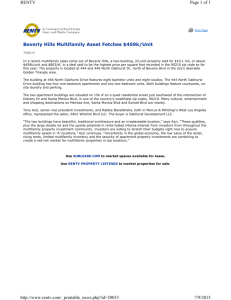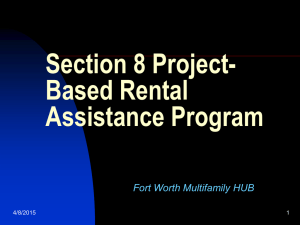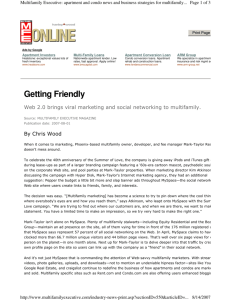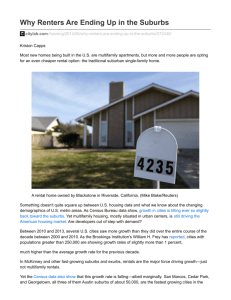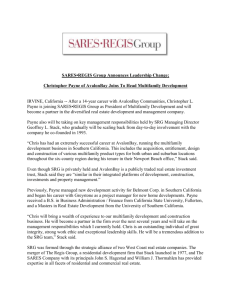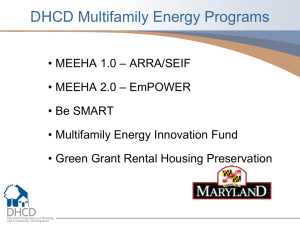2015 Multifamily Outlook
advertisement
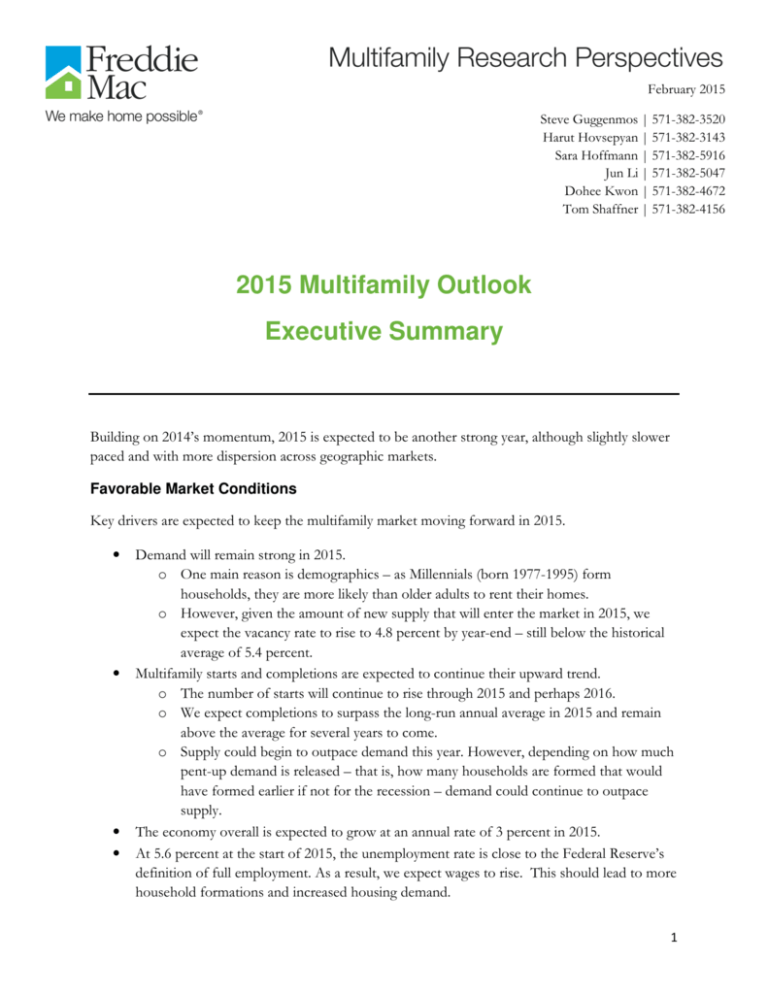
February 2015 Steve Guggenmos | 571-382-3520 Harut Hovsepyan | 571-382-3143 Sara Hoffmann | 571-382-5916 Jun Li | 571-382-5047 Dohee Kwon | 571-382-4672 Tom Shaffner | 571-382-4156 2015 Multifamily Outlook Executive Summary Building on 2014’s momentum, 2015 is expected to be another strong year, although slightly slower paced and with more dispersion across geographic markets. Favorable Market Conditions Key drivers are expected to keep the multifamily market moving forward in 2015. • • • • Demand will remain strong in 2015. o One main reason is demographics – as Millennials (born 1977-1995) form households, they are more likely than older adults to rent their homes. o However, given the amount of new supply that will enter the market in 2015, we expect the vacancy rate to rise to 4.8 percent by year-end – still below the historical average of 5.4 percent. Multifamily starts and completions are expected to continue their upward trend. o The number of starts will continue to rise through 2015 and perhaps 2016. o We expect completions to surpass the long-run annual average in 2015 and remain above the average for several years to come. o Supply could begin to outpace demand this year. However, depending on how much pent-up demand is released – that is, how many households are formed that would have formed earlier if not for the recession – demand could continue to outpace supply. The economy overall is expected to grow at an annual rate of 3 percent in 2015. At 5.6 percent at the start of 2015, the unemployment rate is close to the Federal Reserve’s definition of full employment. As a result, we expect wages to rise. This should lead to more household formations and increased housing demand. 1 • • • The price of oil could affect employment in areas with energy-dependent economies. At a national level, however, the benefits of lower oil prices will outweigh the drawbacks. Expectations are that Treasury rates will not spike up drastically this year. If the 10-year Treasury rate remains below 3 percent, we anticipate that the multifamily capitalization rate will stay under 6 percent this year. With low interest rates and high property prices, loan origination volume is expected to remain strong. Increased Dispersion at the Geographic Market Level Vacancy rates will rise in most Metropolitan Statistical Areas (MSAs) in 2015 as new supply becomes available. Rent growth will vary among markets in 2015. It will grow more slowly as vacancy rates rise; it may be flat or even decline in some markets that have added significant amounts of new supply or see less demand because of slow economic growth. • • • • • In several MSAs, vacancy rates will return to their historical averages. We project that vacancy rates will revert to historical averages in Baltimore, Ft. Lauderdale, Los Angeles, Philadelphia, and Salt Lake City. The list already includes Jacksonville, Norfolk, and Washington, D.C. Our top 10 list of MSAs with the highest percentage of gross income growth and generally low vacancy rates includes many of the usual suspects, such as Boston, New York, and San Francisco. Other markets that were hardest hit by the recession and are now experiencing an upswing in multifamily construction include Miami, Orlando, Phoenix, Oakland, and Riverside. Meanwhile, construction in Sacramento and Las Vegas remains suppressed. We expect more movement on the top 10 list as more households form and demand increases, thanks in large part to improving employment and wages as well as demographics. Special Analysis: Manufactured Housing Manufactured housing, factory-built homes that are transferred to a site for installation, is a small market segment that has been growing in popularity in response to the increasing unaffordability of multifamily and single-family housing. • • • Average rent on a manufactured housing unit in 2013 (latest data available) was more than 40 percent lower than median rent on a traditional multifamily unit. More than half of manufactured housing units are concentrated in six states in the Southeast region plus California and Texas. In addition, this type of housing is more prevalent in smaller cities and municipalities. Occupancies dropped meaningfully during the recession, but are now trending up. Meanwhile, rent growth remains below pre-recession levels. ________________________________________________________ 2 2015 Multifamily Outlook Multifamily rental housing fundamentals outperformed many market forecasts in 2014; strong demand absorbed the increased supply of new units introduced to the market. The amount of multifamily supply that will be delivered in 2015 will surpass pre-recession averages, but favorable demographics and a sturdier economy will produce another strong year for multifamily. Market dispersion will become more pronounced. A look at some of the hardest hit markets during the Great Recession highlights the difference in how those markets are recovering and their expected performance. Manufactured housing is expected to be a vehicle to help bridge the housing affordability gap. Conditions in the manufactured housing market segment are trending up, after a tumultuous decade in the 2000s. ________________________________________________________ The multifamily rental housing market outperformed expectations in 2014 and is expected to remain strong in 2015. Even with a significant increase in new supply delivered to the market in 2014, multifamily vacancy rates remained low and rent growth exceeded expectations. Multifamily property fundamentals are as strong today as any time since the early 2000s. Looking forward, new supply will be higher again in 2015 and dispersion across markets will continue to widen, as new supply is delivered unevenly. At the end of the year, the national rental market will likely be operating at higher vacancy, but with positive revenue growth overall. The macroeconomic backdrop appears brighter for 2015 than it was for 2014. In the first half of 2014, employment surpassed its prior peak, but wage growth remained stagnant and gross domestic product (GDP) growth was uneven. By year-end, the broader economy had steadied. The broader economy now seems to have a solid foundation and growth is likely. Section 1 – Multifamily Market Drivers When all the revisions to the numbers are in, it is likely that the economy grew close to 2.5 percent in 2014. After GDP dropped 2.1 percent (annualized) in the first 3 quarter, the economy rebounded and built momentum entering 2015. The broad consensus of forecasters expects GDP to grow near 3 percent this year. Employment Continues Its Upswing, While Wages Stagnate Employment grew by 3.1 million in 2014, the largest year-over-year gain since 1999. Unemployment dropped below 6.0 percent in September and ended the year at 5.6 percent. The labor market continues to build momentum as total non-farm employment grew by an estimated 3.1 million in 2014, the largest annual increase in the past 15 years. The unemployment rate dropped below 6 percent in September 2014 for the first time since before the recession and ended the year around 5.6 percent. However, growth in wages fell short of the inflation rate, a trend seen since the beginning of the recession. Now that the unemployment rate is near the Federal Reserve’s definition of full employment (5.2-5.5 percent), we expect the growth in real wages to gradually increase in 2015. Employment improved even as the participation rate remains depressed – near its lowest rate since 1977 at 62.8 percent. The rate remains low not only because of discouraged job seekers leaving the workforce, but also because of changes in the demographic landscape. The rate has been declining for several decades because of aging Baby Boomers leaving the labor force. However, the steady increase in total employment is more vital for the economy and the multifamily sector than participation rates returning to previous levels. The large drop in oil prices will impact the economy in 2015. The lower oil prices will benefit many and overall economic growth will likely be stronger as a result. However energy dependent areas could face layoffs or a reduction in job growth. The drop in oil prices makes some extraction processes no longer cost-effective; as a result, some companies will cut capital expenditures. In fact, some have already begun to tighten their belts as prices have dipped below $50 a barrel. The biggest concern is in Texas, which we believe would suffer the most as almost 50 percent of energy related jobs are located in this state. We expect Houston to see the largest number of potential job losses as it’s the sector’s epicenter; however, Houston has become more diversified since the last energy crisis in the 1980s, and, as of the beginning of 2015, is not expected to fall into a recession. Smaller metro areas across Texas could feel the pinch as they are less diversified. Other states, including Alaska, North Dakota, Wyoming, and Oklahoma, are expected to feel the effects as well. Multifamily Market Performance Is Expected To Remain Strong Demand and rent growth in the multifamily market outperformed many economists’ predictions in 2014, despite the flood of new properties that opened their doors during the second half of the year. Vacancy levels declined by 10 basis points (bps) compared to 2013 reaching a 13-year low of 4.2 percent. Demand was strong enough 4 to absorb many of the new units and allow landlords to increase rents. Revenue growth over the past five years has been remarkable. According to REIS, gross revenue per unit is up 20 percent over the last five years. The last time this level of growth was seen was the five-year period ending 2002, when revenue grew 23 percent. Vacancy rates are projected to increase to 4.8 percent while gross income growth will slow to 3.1 percent in 2015 as new completions enter the market. On the new supply side, we expect multifamily completions to surpass the long-run average in 2015 and remain above the average for the next few years (more about supply in the next subsection). Counterbalancing this, we anticipate demand for multifamily units to remain strong in 2015, primarily due to favorable demographic trends and continued expansion of the labor market, which will result in continued rent growth throughout the year. One of the key drivers of multifamily demand is age related. As younger adults (25-34 years old) have the highest propensity to rent, the total number and economic well-being of this age group is a crucial engine for multifamily performance. The 25-34 age cohort reached a peak in 1989 when Baby Boomers reached young adulthood, but then declined until 2006. At that point, Millennials began to enter this age cohort. A new peak should be reached this year or next and continue rising until 2023. The increase in the population of younger adults will keep demand high for multifamily units. We expect that as the economy continues expanding the formation of households among young adults will also trend up. In all, we project vacancy rates will increase slightly by 60 bps, to 4.8 percent by yearend 2015 but remain below the historical average of 5.4 percent, as shown in Exhibit 1. Meanwhile, rent growth is expected to remain strong, but at a lower rate than in 2014. In 2015, with the increase in vacancy rate and moderating rent growth, we forecast that gross income growth will still be up 3.1 percent. Exhibit 1 – Vacancy Rate and Gross Income Growth, History and Forecast Sources: REIS, Freddie Mac Projections 5 Multifamily Supply Continues to Roll onto the Market Multifamily construction in 2014 continued its upward trend, reaching levels not attained since the 1980s. We expect this trend to continue through 2015 and possibly into 2016. As depicted in Exhibit 2, starts of multifamily properties with five or more units ended 2014 at 341,000 units (annualized), about 50,000 units higher than the long-run average from 1995-2007. Despite the higher-than-average starts in multifamily, total housing starts (including single-family, two to four units and multifamily) remains well below historical average. Therefore, with the increasing demand for housing, the rise in multifamily starts is not expected to put a significant amount of pressure on the vacancy rate, which is expecting only moderate increases as noted above. Exhibit 2 – Multifamily Starts and Completions (5+ Units) and Employment Sources: Freddie Mac, U.S. Census Bureau, Moody’s Analytics Also shown in Exhibit 2 is the lag between starts and completions, reflecting the time required to build multifamily properties. In 2014, completions increased by about 67,000 units (annualized), or 36 percent year-over-year. In total, 251,000 units were completed in 2014, still 18,000 below the long-run average from 1995-2007. The pace of construction is expected to slow down in the mid-term, but as multifamily permits are still increasing year-over-year, construction starts and completions will continue to increase for several more years. However, in our 2014 Mid-Year Outlook, we estimated that the supply of new multifamily units needs to be around 440,000 units annually in order to meet the 6 growing demand.1 This level of demand includes pent-up households that delayed formations during the Great Recession. As the economy grows, the pent-up demand will be released. We forecast that completions will rise above the historical average of 270,000 units but remain below the 440,000 units needed over the next few years. While the timing of the realization of pent-up demand is hard to predict, we expect that the wave of current supply will not disrupt the market and will be absorbed within the mid-term. Property Valuations Exceed Expectations, Interest Rates Remain Low Consistent with improving multifamily revenues, property price growth also advanced robustly in 2014. According to Real Capital Analytics (RCA), multifamily property values increased about 15 percent in 2014. Strong fundamentals and investor appetite for multifamily investments will propel further property appreciation in 2015. With the drop in 10year Treasury rate and multifamily cap rate in 2014, the cap rate spread increased to 377 bps. We expect spreads to tighten slightly to 300-330 bps in 2015. Multifamily capitalization rates decreased by 16 bps in 2014, ending the year at 6 percent. With the recent decline of the Treasury rate, the cap rate spread increased to 377 bps, as shown in Exhibit 3. Treasury rates remain low due to a number of factors, including political uncertainty around the world and the Federal Reserve holding down rates. After the 10-year Treasury rate rose over 100 bps in 2013, it slid 70 bps throughout 2014, ending the year around 2.3 percent. The rate continued to fall into 2015, ending at 1.9 percent in January. Freddie Mac projects a slow increase throughout 2015 to end the year back at 2.3 percent. Our analysis indicates that multifamily cap rates will stay below 6 percent in 2015. This forecast is consistent with steady employment growth, the 10-year Treasury rate remaining below 3 percent, and spreads continuing to tighten mildly to 300-330 bps. 1 “Mid-Year Housing Outlook: Finding A New Normal,” Freddie Mac Multifamily Research. See http://www.freddiemac.com/multifamily/news_research/research.html. 7 Exhibit 3 – Multifamily Value Index, Cap Rate Spread and Treasury Rate Sources: Freddie Mac, RCA, U.S. Census Bureau, Moody’s Analytics Origination Volume and Competition Are Up Total multifamily volume ended 2014 strong and is expected to be higher in 2015, but the level of growth depends on several market factors. Multifamily origination volume for 2014 was notable for a very strong second half, ending the year above $185 billion, $13 billion more than the previous year, despite a slow start. The increase in volume during the second half of 2014 can be attributed to several factors, including decreasing interest rate, increasing construction completions, and increasing property prices. More investors are likely to take advantage of the lower-interest-rate environment by refinancing outstanding debt or funding new completions. As new development comes into the market, this not only fuels transaction volume of new buildings, but also causes buyers to re-position their real estate portfolios by selling and refinancing assets. As property prices have risen over the past few years, average debt per unit in newly completed buildings has risen, which also has driven up origination volume. As shown in Exhibit 4, 2015 is on pace to be another substantial year for multifamily originations. The year also saw a steep increase in the market share of commercial mortgagebacked security (CMBS) conduits. While the share of this sector was still below prerecession levels and the sector constitutes only 5.8 percent of the total market share, the steep upward trend since 2011 is an indication of a strong and growing appetite for multifamily loans. The shares of other players remained relatively stable compared to the previous year. We anticipate that the capital flowing into the multifamily debt market will continue to be abundant as the high yields and strong fundamentals are likely to persist in the mid-term. 8 Exhibit 4 – Multifamily New Purchase and Guarantee Volume ($ Millions) Sources: Mortgage Bankers Association, Freddie Mac Notes: 2014 and 2015 numbers are projections as of December 2014 Single-Family Market Conditions Still Lag Despite the low-interest rate environment, the single-family housing market remained sluggish in 2014. The Freddie Mac Multi-Indicator Market Index (MiMi), which measures the single-family markets’ stability, shows slight improvement in 2014, but not enough to elevate it from a rating of “weak”. Single-family starts in 2014 increased only 4.1 percent compared to 23.6 and 15.7 percent in 2012 and 2013, respectively. Home price appreciation in 2014 was also lower than the previous two years, at 5 percent compared to 6 and 9.3 percent, respectively. The outlook for 2015 is more optimistic, boosted by low interest rates, easing credit standards, and lowered Federal Housing Administration (FHA) mortgage insurance rates. Freddie Mac’s most recent Economic and Housing Market Outlook forecasts home price appreciation in 2015 will be around 3.9 percent. While lower than the previous few years, long-run home price appreciation is 3 percent, indicating that the single-family market is stabilizing towards historical average levels. Although single-family is recovering at a slow rate, rising home prices will lower affordability for many families. Section 2 – Multifamily Market-level Outlook Narrowing in on the top 36 markets we track, two trends regarding supply became apparent at the end of 2014: More metro areas have elevated supply compared to their historical averages, which is evident in Exhibit 5; at the same time, the amount of new supply coming into the market slowed down in several metros that were experiencing very high levels of construction in the previous year. Multifamily starts in 2014 were highest in Dallas, Houston, Nashville, San Jose, and Washington, D.C. 9 More markets will see an increase in multifamily construction, indicating growing developer confidence in many markets. Meanwhile, vacancy rates are creeping up in a majority of the markets we track, also shown in Exhibit 5. Many are still below their historical averages but, as new supply is delivered, a rise in vacancies is expected. Markets that saw large increases in supply over the past few years could see year-over-year vacancy rates increase in the magnitude of 100-200 bps: Austin, Denver, Houston, Nashville, Phoenix and Salt Lake City. Even with that significant an increase, the majority will remain below their historical average, except for Salt Lake City, which is expected to revert to its historical average in 2015. Several other markets are also expected to revert to their historical averages, but with more modest increases in vacancy rates of 10-90 bps: Baltimore, Ft. Lauderdale, Los Angeles, and Philadelphia. Washington, D.C., Norfolk, and Jacksonville have already normalized to the average as of 2014. Exhibit 5 – Multifamily Starts and Forecasted Vacancies Relative to History Sources: REIS, Moody’s Analytics, Freddie Mac projections Also in 2015, we project rent growth in the majority of markets will continue to outperform historical averages and exceed the expected inflationary rate of 1.9 percent, as shown in Exhibit 6. However, rent growth in both Washington, D.C., and Memphis will fall short of expected inflation. Additionally, rent growth rates will match the inflation rate in Austin, Indianapolis, and Minneapolis. Of these, Austin’s vacancy rate has almost fully reverted to its historical average and multifamily starts remain elevated, indicating rent growth in Austin could slip further as it continues to balance itself from the large inflow of new supply. 10 Exhibit 6 – Rent Growth Forecasts Relative to History Sources: REIS, Freddie Mac projections Our projected top 10 markets by gross effective income growth for 2015, which incorporates both rent growth and vacancy rates, are shown in Exhibit 7. The top 10 markets listed here are very similar to those in our 2014 Mid-year Outlook, but with San Jose and Sacramento in place of Orange County and Baltimore. The strong performance in many of these markets stems from absorption of supply due to either high demand fueled by a strong job market (e.g., Seattle) or a healthy job market paired with relatively limited multifamily stock (e.g., Oakland). Exhibit 7 - Top 10 Metro Effective Income and Vacancy Forecasts Metropolitan Market San Francisco, CA Oakland, CA Seattle, WA San Jose, CA New York, NY Sacramento, CA San Diego, CA Denver, CO Portland, OR Boston, MA United States (top 70 metros) Annualized Growth in Gross Effective Income 2015 Vacancy Forecast 2015 4.9% 4.2% 4.0% 3.9% 3.9% 3.9% 3.8% 3.8% 3.7% 3.7% 3.0% 3.2% 4.7% 3.2% 2.6% 3.3% 2.9% 5.6% 3.3% 4.1% 3.1% 4.8% Source: Freddie Mac projections Our top 10 also includes some markets that were hard hit during the recession: Oakland and Sacramento. Given that, it is interesting to look at a broader list of hard-hit markets to better understand how they are emerging from the significant 11 Some traditionally single-family markets that were hit hard during the recession are starting to see life in the multifamily space. housing market stress each underwent. Here, we classify the hardest hit markets as those with the largest drop in single-family home prices from their peak to their trough, as shown in Exhibit 8. Many of these markets have been “under the radar” relative to other markets because of potential risks of supply overhang from the recession. The question is whether the drivers of the individual economies have regained enough strength that one might expect growth in multifamily demand and, subsequently, pickup in multifamily developer confidence. Exhibit 8 – Markets with the Largest Drop in Single-Family House Prices Metropolitan Market Drop in Prices from Peak to Trough Difference in Current Prices* to Pre-Recession Peak -62% -57% -57% -55% -54% -54% -49% -34% -43% -37% -35% -33% -34% -37% -20% -19% Las Vegas, NV Riverside, CA Phoenix, AZ Sacramento, CA Miami, FL Orlando, FL Oakland, CA United States Source: CoreLogic, Inc. *Recent data through 2014 Q3 Consistent with the rest of the country, recovery is taking hold in these markets, but not in a synchronized manner; local market dynamics are playing a big role in how each market recovers. Some of the markets are coming back at a relatively slow pace, others are quietly becoming very strong performers, and still others will likely not be positioned to grow for a while. Exhibit 9 illustrates how employment has tracked since the pre-recession peak and the differences across the metros. All of these markets experienced more job losses than the national average. So far, only three metros have regained all lost jobs in terms of numbers: Miami, Orlando, and Oakland. Because employment is a key driver of household demand, markets struggling to produce jobs will likely have a less robust housing market. While several markets still lag their pre-recession peaks, all seven markets have experienced larger gains in employment growth over the past three years than the national average. 12 Exhibit 9 – Employment Growth (2008Q1 = 100) Source: U.S. Census Bureau, Freddie Mac Multifamily construction in most of the hard hit markets has been muted over the past few years, despite strong absorption rates. Exhibit 10 shows the past three years’ worth of multifamily starts along with the prerecession average. Phoenix and Orlando surpassed or reached their pre-recession norms in 2014; Phoenix due to the well-below-average vacancy rate and high absorption, despite lagging employment, while Orlando has benefited from impressive job growth and increasing multifamily demand. Construction is rising to moderate levels in other markets, such as Miami, Oakland, and Riverside, whereas Sacramento and Las Vegas remain well below their long-run averages. However, demand in all of these markets continues to outpace new supply. All of these markets saw higher absorption rates than completion rates in the past three years. Exhibit 10 – Multifamily Starts 2012 – 2014 Relative to History Source: Moody’s Analytics, Freddie Mac 13 Exhibits 11 and 12 compare year-over-year vacancy and rent growth to their historical norms. Vacancy rates will remain below pre-recession averages in 2015 due to the low supply; however, rates are expected to rise throughout the year in all markets, except in Las Vegas. Even with the relatively small amount of supply being delivered to some of these markets, it’s enough to cause vacancy rates to increase because many of these markets have seen some of the lowest vacancy levels in years. Exhibit 11 –Vacancy Rates in 2014, Forecasts for 2015, Relative to History Sources: REIS, Freddie Mac projections At the same time, rent growth will be mixed across the markets. Those markets that have seen very low levels of construction will be able to increase rents into 2015 (Riverside and Sacramento); even so, rents may still remain below historical averages. In other markets that have already added a decent amount of new supply to the market (Phoenix, Orlando, and Miami) or where demand is still limited due to lack of economic growth (Las Vegas), rents will remain flat or decline. Exhibit 12 – Rent Growth in 2014, Forecasts for 2015, Relative to History Sources: REIS, Freddie Mac projections 14 Next, we take an in-depth look at what is driving vacancy and rent growth performance in these markets. In a nutshell, we expect performance among these markets to be mixed over the next few years. After a few strong years in Miami, the new supply will cause vacancies to increase and rent growth to moderate. Several California markets will be on our top 10 list for income growth due to low supply and increasing demand. Meanwhile, Las Vegas, Orlando, and Phoenix are expected to perform near their long-run averages. Phoenix saw its first quarter of higher completions than absorptions in the third quarter of 2014. High absorption rates in 2010 and 2011 kept vacancy rates low and allowed rents to climb above historical averages. These favorable fundamentals fueled new construction projects, which started to hit the market at the end of 2014. New supply is expected to outpace demand in 2015, which will increase vacancies and slow rent growth. Vacancy rates could jump up around 200 bps in Phoenix in 2015. However, fundamentals are still expected to remain within long-run averages because the market will remain very cautious not to over-build during this period. The strong employment growth in Miami and Orlando has increased demand for households, allowing construction to pick up over the past few years. As of 2014, supply and demand in both markets were nearly balanced; going forward, new supply is expected to outpace demand. Both markets will see the gap in vacancy rates tighten in 2015, but Miami will also see rent growth slow, whereas Orlando will remain near its historical average. Orlando has experienced near-historical-average rent growth the past several years, while Miami has seen above-average growth. The Miami market is correcting itself, which could cause rents to dip below the historical average. Oakland will also see rent growth drop in 2015 due to new supply coming into the market, but will still perform better than its historical norm. Oakland will remain one of our top 10 markets into 2015 as demand is high and vacancies are low. Much of the demand for housing in Oakland is coming from the thriving economies of neighboring San Francisco and San Jose. As residents are being priced out of these Bay-area cities, people are moving to Oakland for more affordable housing. This will keep rent growth elevated and vacancies low, even as new supply comes online. Sacramento and Las Vegas have the lowest completion-to-absorption ratio over the past few years due to their slow economic recovery. Both economies are heavily dependent on a single industry: government for Sacramento and leisure and hospitality for Las Vegas. This reliance on a single industry creates less diversity and usually results in a slower recovery after an economic downturn. However, Sacramento, as opposed to Las Vegas, is expected to see greater growth over the next few years. Sacramento will be in our top 10 metros in 2015 due to strong economic growth, resulting in strong household demand and extremely limited 15 multifamily construction. Meanwhile, the Las Vegas economy will continue its slow but steady recovery, allowing vacancy rates to decrease slightly but rent growth to remain near historical norms until demand for multifamily strengthens. The recovery in Riverside has finally started to turn the corner over the past year. While the overall employment level is still below the pre-recession peak, there has been very strong job growth, a total of 10 percent since 2012. In addition, with construction yet to pick up, multifamily fundamentals have been favorable. Even though Riverside rent growth remains below its historical average of around 6 percent, rents will increase in 2015 and vacancies remain near historic lows. The market is poised to perform well in 2015 due to strong demand and limited supply. Overall, these seven markets are expected to continue to see steady growth, although their paces will differ. Several markets will see demand pick up in the next few years, while others will remain subdued. While these three California markets are expected to see strong multifamily growth, they are traditionally single-family markets. As such, developers should remain cautious regarding the amount of supply that should be introduced to these markets. Section 3 – Manufactured Housing: Overview and Outlook Manufactured housing offers a means of more affordable housing. Manufactured housing is commonly defined as factory-built homes that are transferred to a site for installation. Manufactured home communities are relatively affordable and provide benefits including privacy, larger homes, and attractive amenities. In the face of the widening housing affordability gap, the sector delivers quality living at a lower cost per square foot than conventional single-family and multifamily sectors. However, it is a small segment of the market. Like other housing market segments, construction dropped significantly compared to historical levels after the recession. In the United States, 6.7 million households reside in manufactured housing, or 5.8 percent of all households, according to the 2013 American Community Survey (ACS). Similar to the overall household rate, about one-third of households living in manufactured homes are renters. More than 50 percent of rental manufactured homes are concentrated in eight states, generally in the southern region but also including California and Texas, as shown in Exhibit 13. North Carolina tops the list of manufactured rental units by state. Its national share of rental manufactured homes is 9.7 percent but it only accounts for 2.4 percent of all multifamily rental stock. Exhibit 13 also shows how the sector provides affordable units with relatively lower costs compared to multifamily and single-family rental units. In 2013, the median rent for a manufactured home was $450, which was 42 percent lower than the 16 median rent for a multifamily unit. The affordability of rental manufactured housing is almost universal across the states. California has one of the highest manufactured housing median rents at $650, but this was still more than 40 percent lower than median multifamily and single-family rent in the state. Exhibit 13 – Manufactured Rental Housing Stock and Median Rent by Housing Type in 2013 State North Carolina Manufactured Rental Occupied Stock (Number of Households) Manufactured Home Median Rent (Dollars) Multifamily Median Rent (Dollars) Single-Family Median Rent (Dollars) 183,669 420 680 650 Texas 164,939 500 710 800 Florida 152,931 520 830 940 California 117,971 650 1100 1200 Georgia 111,681 400 700 750 South Carolina 99,562 450 670 650 Tennessee 76,811 400 600 630 Alabama 72,850 400 550 550 1,897,954 450 780 800 Total Source: American Community Survey 2013, Freddie Mac Since the 1970s, the number of manufactured housing completions has decreased significantly due to the boom of the single-family market. Exhibit 14 further illustrates the concentration of manufactured housing completions across market segments since 1970. Over time, completions of manufactured homes have significantly declined. Total completions were north of 500,000 units per year in the early 1970s and averaged 300,000 units per year in the mid-1990s. However, the total number of completions plunged to about 100,000 units per year in the early 2000s during the boom of the single-family housing market. Just like the conventional housing sectors, completions of manufactured homes reached historically low levels during the Great Recession, dropping below 50,000 units per year. Completions of manufactured homes have gone up to about 61,000 units per year since 2013, but still remain low compared to historical levels. The vast majority of completions were in tertiary markets, which are smaller Metropolitan Statistical Areas (MSAs), and non-MSAs. The share of completions in primary and secondary markets has increased in recent years, largely driven by the affordability these homes offer. 17 Exhibit 14 – Total Manufactured Housing Completions (Thousands, Annualized) and Share by Market Type Source: U.S. Census Bureau, Moody’s Analytics, Freddie Mac The majority of manufactured housing completions have been concentrated in tertiary and non-MSA markets. Exhibit 15 depicts the share of multifamily, single-family, and manufactured homes by market segments completed in 2013 and 2014. The combined share of completions in primary and secondary markets constitutes less than 20 percent of the total manufactured housing completions, whereas completions in non-MSAs compose the largest share, at 41 percent. In contrast, multifamily completions are roughly evenly distributed across primary, secondary, and tertiary markets, with 28, 37, and 29 percent, respectively. Furthermore, the share of multifamily completions in non-MSAs is only 6 percent. While single-family completions are more skewed toward smaller markets, less than 13 percent are built in non-MSAs. Exhibit 15 – Share of Completions by Housing Type and Market Segment (2013 – 2014) Source: U.S. Census Bureau, Moody’s Analytics. Freddie Mac 18 Manufactured housing performance was hurt during the single-family housing boom, but has started to recover. Manufactured housing occupancies were falling well before other housing sectors were hit by the effects of the Great Recession. Exhibit 16 shows the occupancy rates and rent growth from 2000 to 2014. Despite the low supply of manufactured homes in the early 2000s, the sector declined in occupancy as it struggled to compete with the booming single-family sector. After the economy tanked, manufactured housing occupancy continued to decline as the stress of the recession heavily impacted all sectors of the housing market. The occupancy decline slowed, then stabilized, and is now trending slightly upward again. Rents, in turn, have returned to more respectable annual increases but, at around 2.5 percent, are still below prerecession average levels. In many markets, manufactured housing community owners are leasing homes and sites as a total package that is competitive with, and in most cases below, the local multifamily housing rental rates. As demand has risen, rents have gone up around 3-4 percent in many markets as confidence from the improved occupancy has resulted in greater rent growth. Exhibit 16 – Manufactured Housing Occupancy and Rent Growth Source: Datacomp / JLT & Associates, Freddie Mac The manufactured housing sector has been declining since 2000. But with an increasing affordability gap in the multifamily and single-family sectors, it seems that the manufactured housing sector is turning the corner. With the cost of this housing lower than in the conventional multifamily sector and single-family rental sector, manufactured housing offers a more affordable alternative for many households. The sector has seen an upward trend in occupancy and improvement in rent growth since 2012. The trend is likely to continue in the near to mid-term as demand for affordable housing is expected to increase. 19 Conclusion The multifamily market will see another strong year in 2015, albeit at lower levels than in 2014. Even as many more properties are completed and new supply is delivered to the market, demand and absorption rates will remain high through 2015 due to favorable demographics and an overall sturdier economy. However, we will see more dispersion across metro areas as some smaller metros that have been slower to recover pick up steam. We expect to see improved growth in the manufactured housing sector as housing affordability continues to be squeezed across the nation. For more insights from the Freddie Mac Multifamily Research team, visit the Research page on FreddieMac.com/Multifamily. 20

